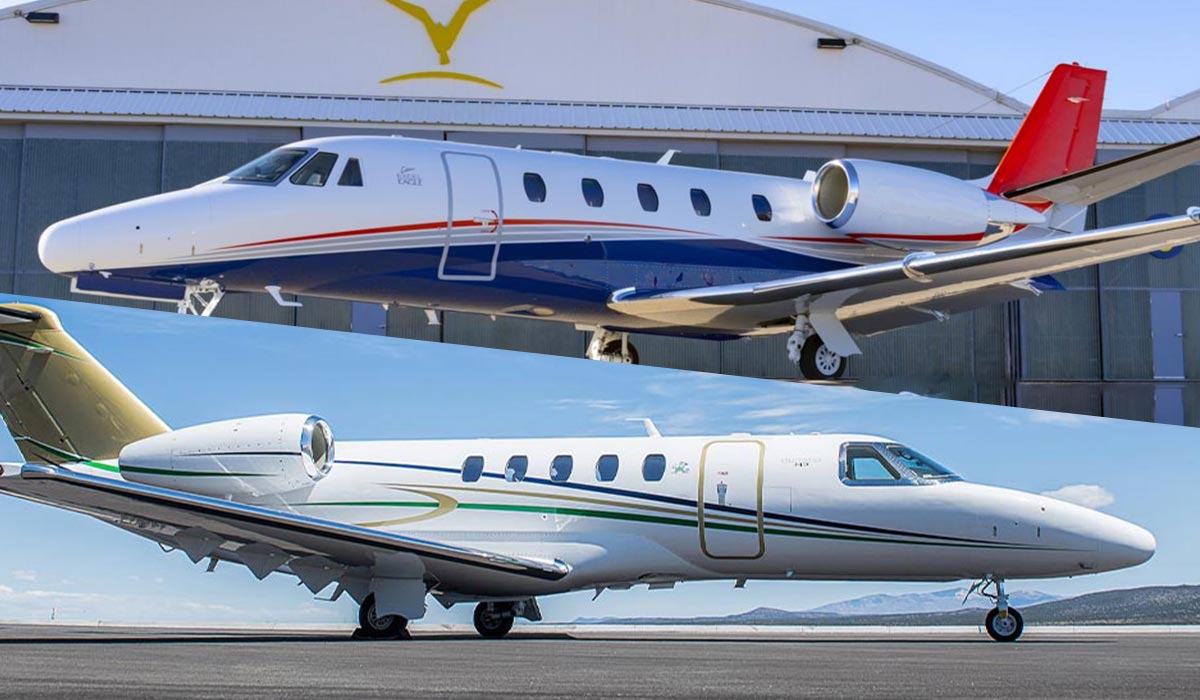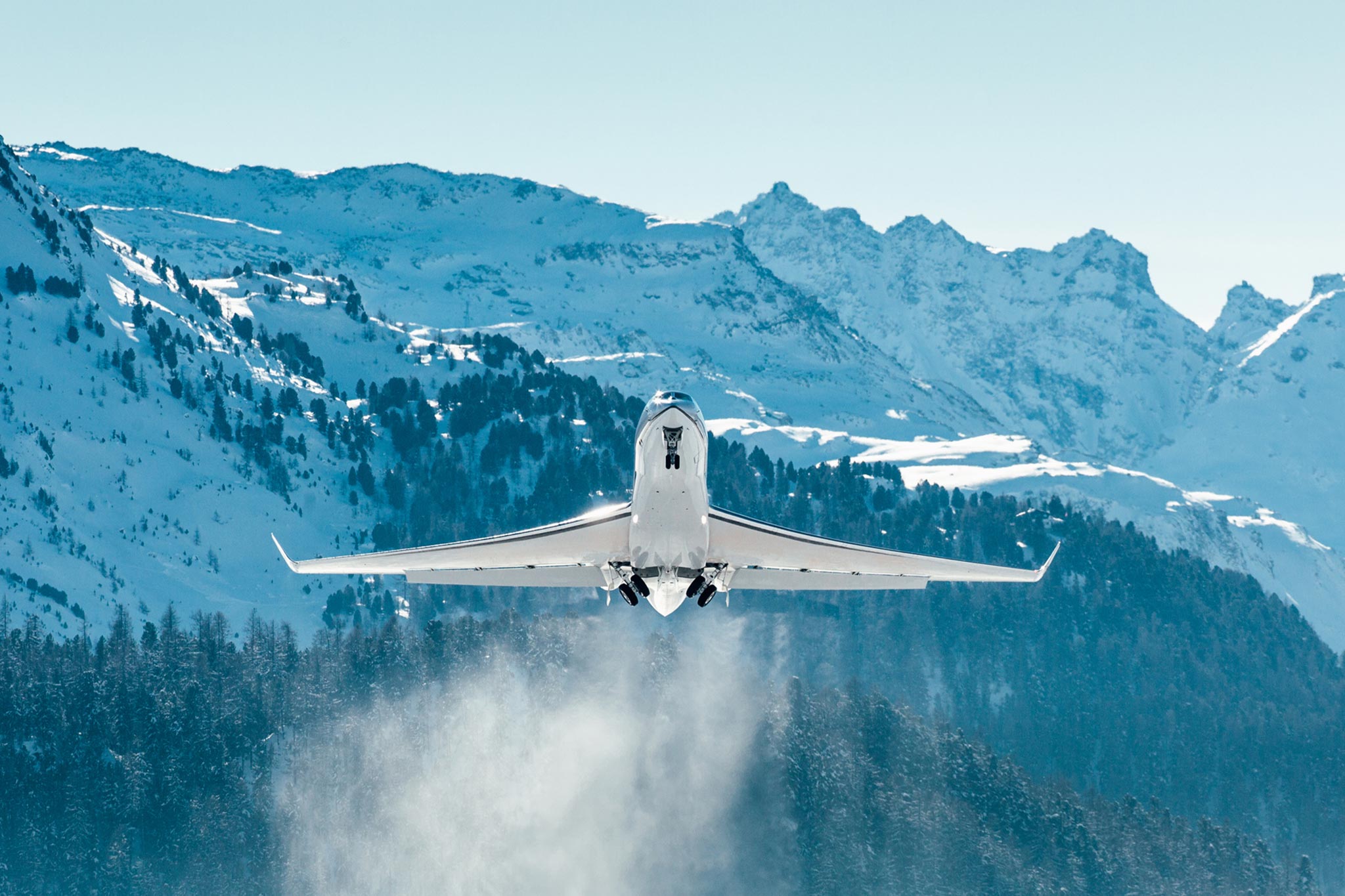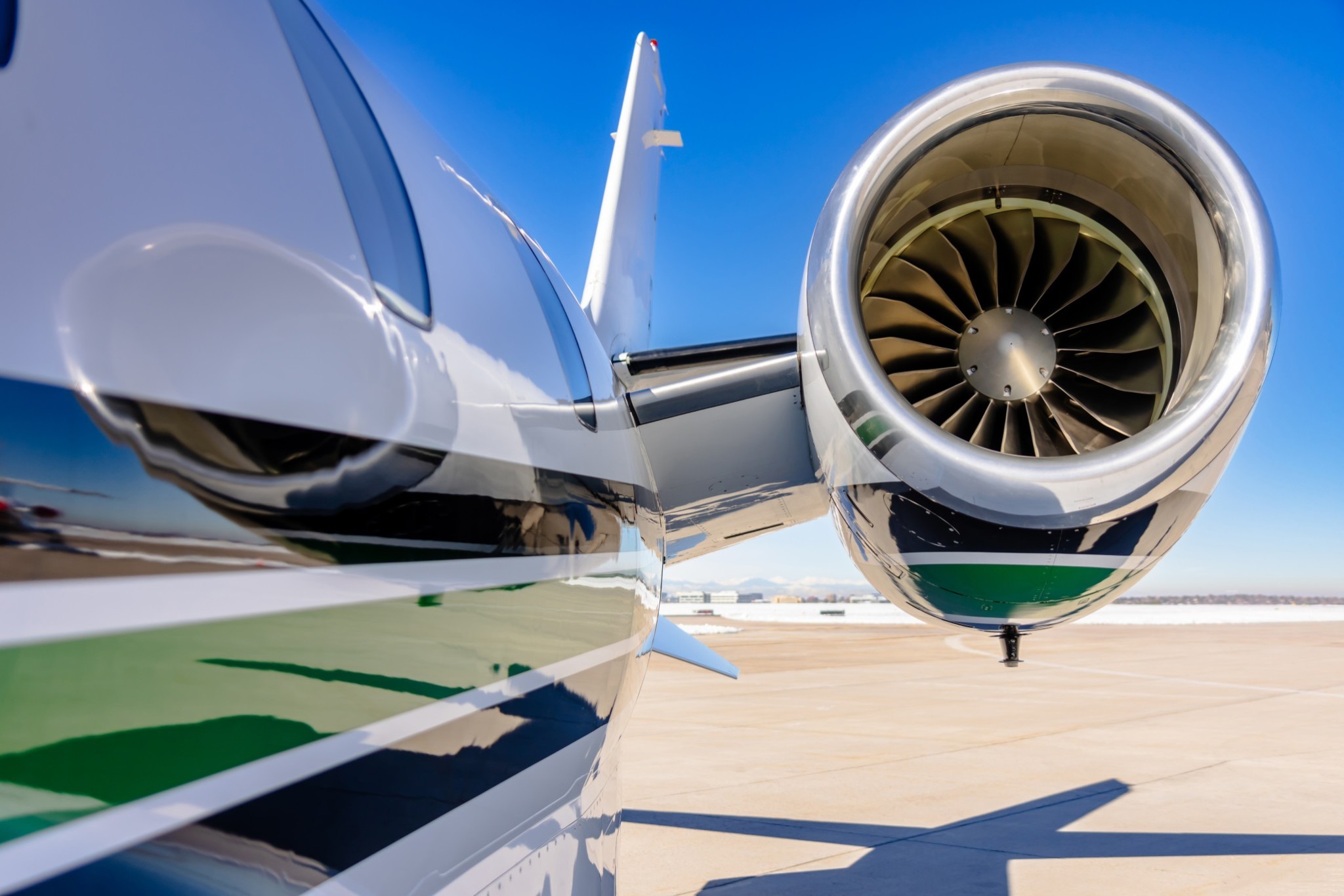
Something Like A Phenomenon
Date
July 9, 2009Flying Embraer’s first entry-level jet, the Phenom 100
By Ron Mohrhoff
There’s a saying, “A plane usually flies like it looks.” I put that to the test on Embraer’s latest release, the Phenom 100. My first impressions of the Brazilian-made machine? It looks big, really big. It looks fast and sporty, with its sleek nose design and relatively short wings. It looks like a real-deal corporate jet, beyond a VLJ.
Walkaround
My review started with a detailed walk around the aircraft exterior. I started at the door. Ask any aircraft designer what one of the hardest parts to design is, and you’ll likely get the following answer: the door.
Embraer put a tremendous amount of effort into designing the Phenom’s door, making those lucky enough to board feel as if they’re getting into a Gulfstream, not a jet that costs a fraction of the price. A simple twist of the embedded door handle begins an impressive mechanical ballet as the massive airstair door, with perfect balance, lowers to the ground, providing access to the cabin.
 The particular aircraft I evaluated was equipped with the optional premium passenger door, which includes stainless-steel supports that hold the door at the proper height, once deployed. The premium door also adds LED lighting to brighten up the airstair for those late-night entries. What’s more striking is how well balanced the door is when you need to close it. It literally takes just your index finger to push up on the handrail and lift the door to the closed position—very impressive engineering.
The particular aircraft I evaluated was equipped with the optional premium passenger door, which includes stainless-steel supports that hold the door at the proper height, once deployed. The premium door also adds LED lighting to brighten up the airstair for those late-night entries. What’s more striking is how well balanced the door is when you need to close it. It literally takes just your index finger to push up on the handrail and lift the door to the closed position—very impressive engineering.
As I walked toward the nose of the aircraft, it was hard not to notice the height at which the aircraft sits. The ground clearance on the Phenom 100 is about the same as on the Hawker Beechcraft Premier 1A. On the left side of the nose is the baggage area. Due to the location of systems in the nose, Embraer was challenged to put much useful baggage space there. With a total baggage capacity of about seven cubic feet in the nose, you’re limited to a small handbag and/or chocks and engine covers in that space. The larger and more practical baggage space is in the aft fuselage, accessed beneath the left engine; it holds 53 cubic feet of space. There’s a forward cabin wardrobe and seven cubic feet in the aft cabin lavatory cabinet.
 The Prodigy integrated flight deck by Garmin provides pilots with graphical system status synoptics on the MFD.
The Prodigy integrated flight deck by Garmin provides pilots with graphical system status synoptics on the MFD.The radome houses the optional Garmin GWX 68 radar, which provides both lateral and vertical profiling of hazardous weather. I am, however, a little surprised that an aircraft of this level and value has radar as optional (and not standard) equipment.
On the right side of the fuselage, I inspected the nose-steering linkage pin to ensure that it was connected. Unlike most light jets, the Phenom 100’s nose-steering linkage can be disconnected, giving operators the ability to spin the nosegear 360 degrees, and making ground handling more versatile for FBO linemen. All three landing gear also require ground-handling pins as protection from accidental collapse when the ship’s hydraulic system isn’t activated. The Goodyear tires are pressurized to a surprisingly high pressure of roughly 170 psi, which contributes to the Phenom 100 being a little “skippity” on landing—more on that later.
Continuing my walkaround, I inspected the three pitot tubes powering three independent air data computers, along with the angle-of-attack sensor that provides data to the Garmin Prodigy system to display 1.3 multiplied by Vso or Vs (depending on the aircraft’s configuration) on the airspeed tape, a handy feature that helps operators double-check their landing speeds.
The Phenom 100’s nearly 450 mph top cruise speed can be partly attributed to its wing design. Due to its relatively low-aspect-ratio wing, the Phenom 100 gets good cruise speed efficiency, handles turbulence well and requires special attention during slow-speed flight. The Phenom 100 is equipped with a stick pusher that’s activated when the aircraft reaches an angle of attack close to the critical angle of attack. When the stick pusher engages, the elevator control is pushed forward before the aircraft can reach a stall. Additionally, added to the upper surface of the wing are a series of two stall fences that help keep flow attached and aligned during slow-speed flight.
The ergonomics of the Phenom 100’s roomy, airline-influenced cockpit provides for both a comfortable and easy-to-use environment for any flight crew.
 The ergonomics of the Phenom 100’s roomy, airline-influenced cockpit provides for both a comfortable and easy-to-use environment for any flight crew.
The ergonomics of the Phenom 100’s roomy, airline-influenced cockpit provides for both a comfortable and easy-to-use environment for any flight crew.The Phenom’s wing and tail leading edges are protected from icing by silver-colored rubber deice boots. Because of the emphasis Embraer placed on fuel efficiency and low acquisition cost with the Phenom 100, keeping the leading edges protected by deice boots—as opposed to heated anti-ice “hot wings”—was an important design decision. The Phenom 100’s two trusty Pratt & Whitney Canada (PWC) PW617F-E engines aren’t robbed of nearly as much valuable bleed air when protecting the wings and tail as they would be with a hot-wing design.
The PW617F-E is the third 600-series engine that PWC has certified. The PW615F was the first, installed on the Citation Mustang, and the PW610F was the second, installed on the Eclipse 500. Because the general design of all three engines is almost identical, PWC was able to learn from the nearly 1,000 engines built throughout the 600-series to further improve on the PW617F.
The Phenom 100’s engines are controlled by dual full authority digital engine control (FADEC) computers, providing full hot- and hung-start protection (a big benefit in avoiding the costly consequences associated with a hot start, which may cost up to $100,000). Starting the engines on the Phenom 100 is as simple as starting your car: Take the start selectors from the “off” position and twist them to the “start” position. That’s it.
Designed by the folks at BMW, the interior is modern and functional. The aircraft has a roomy cabin with large windows and comes standard with four seats in a club-style configuration. The fully enclosed lavatory in the aft of the cabin comes standard with a flushing electric toilet; 110 VAC outlets under the passenger armrests can power laptops or DVD players.
 Ben Marcus (demo pilot) and Cyrus Sigari grinning ear to ear after a great flight.
Ben Marcus (demo pilot) and Cyrus Sigari grinning ear to ear after a great flight.Put To The Test
For the test flight, I flew from Van Nuys, Calif., to St. George, Utah, and back. Sliding into the left seat, I got a chance to evaluate the business end of the Phenom 100—the cockpit. It comes equipped standard with the Garmin G1000–based Prodigy integrated flight deck. As opposed to a dozen or so other currently certified G1000-equipped aircraft, the Prodigy also provides complete synoptic system information, graphically depicting status on the MFD.
Prior to resting my hand on Embraer’s signature “ram’s horn” flight controls, I was a little skeptical of the design. With the natural resting position of the human hand being turned more inward rather than outward, however, I found the design to be very comfortable and effective.
After getting the engines started, getting clearance and plugging in the flight plan using the FMS keypad, I tested Embraer’s electronic braking system. When pushing on the brake pedals, electronic signals are sent to the brake computer, which ultimately meters hydraulic pressure to activate the brakes. The synthetic force feedback provided by a series of springs located in the pedal assembly takes a little getting used to.
 Once cleared for takeoff, I entered the runway, stood up the throttles to takeoff power, and listened to the meaty Pratts spool up to full power while holding the brakes. Upon engine stabilization and brake release, the Phenom leapt forward with a high rate of acceleration. With a takeoff weight of 9,800 pounds and a temperature of 20 degrees C, the Phenom quickly accelerated to the rotation speed of the day, 101 knots, using about 2,200 feet of runway to break ground. Climbing through 1,000 feet, I engaged the GFC 700 autopilot, brought the flaps up and ran the climb checklist. Once cleaned up, we climbed out of the Southern California sky at a stabilized climb rate of about 2,800 fpm at 200 knots indicated. Due to the short flight distance and crowded skies in the Southwest, the flight would be limited to FL290, which the aircraft reached in 13 minutes. Had I climbed all the way up to FL410, it would have taken a total time of 27 minutes.
Once cleared for takeoff, I entered the runway, stood up the throttles to takeoff power, and listened to the meaty Pratts spool up to full power while holding the brakes. Upon engine stabilization and brake release, the Phenom leapt forward with a high rate of acceleration. With a takeoff weight of 9,800 pounds and a temperature of 20 degrees C, the Phenom quickly accelerated to the rotation speed of the day, 101 knots, using about 2,200 feet of runway to break ground. Climbing through 1,000 feet, I engaged the GFC 700 autopilot, brought the flaps up and ran the climb checklist. Once cleaned up, we climbed out of the Southern California sky at a stabilized climb rate of about 2,800 fpm at 200 knots indicated. Due to the short flight distance and crowded skies in the Southwest, the flight would be limited to FL290, which the aircraft reached in 13 minutes. Had I climbed all the way up to FL410, it would have taken a total time of 27 minutes.
 The optional premium passenger airstair door includes chromed supports and LED lighting.
The optional premium passenger airstair door includes chromed supports and LED lighting.Once in cruise, I pulled power back to the cruise position and watched the aircraft accelerate to 393 knots, burning 966 pounds of fuel per hour, or 145 gph, precisely as advertised. Take the Phenom 100 up to FL410 on a standard-temperature day, and it’ll cruise at about 340 knots and burn 520 pounds of fuel per hour, or about 78 gph, providing a significant fuel savings when flying at high altitudes.
As we transitioned from SoCal Approach and checked in with L.A. Center, I threw the controller for a bit of a loop. “Uh… what kind of plane is that you’re flying there?” With only 20 Phenom 100s in North America at this writing, controllers, FBOs and pilots alike are all still getting to know this new little jet. By the end of 2009, Embraer expects to have about 100 Phenom 100s delivered. Not bad for the first full year of production!
As I continued along to St. George, I took some noise readings. The cockpit’s noise level was fantastic; no headsets needed to speak to your copilot. The noise signature at cruise was measured to be 80 dB, and 81 dB in the aft cabin.
Before I knew it, it was time to begin the descent into St. George. Descending the Phenom 100, like any jet, requires preparation and planning. Due to high speed and high flying altitudes, it’s not uncommon to start the descent 100 nm before your destination. Descents are commonly done at an Mmo of Mach 0.70 or a Vmo of 275 knots indicated (with true airspeeds reaching above 400 knots).
As I evaluated the arrival into St. George, I decided to shoot the LPV approach. Because of the momentum associated with an aircraft that has a maximum takeoff weight of 10,472 pounds, a slick airframe, no speed brakes, a gear speed of 275 knots and an initial flap speed of 200 knots, it takes a little work to get the machine slowed down for the approach. If you’re not slowed down below 180 knots before you capture glideslope on an ILS or LPV approach, it will be difficult to slow the aircraft down. That being said, all it takes is a little planning.
 I let the autopilot shoot the approach until 500 feet, disconnected the autopilot and went visual. Crossing the threshold, I brought throttles to idle, and brought the 100 in for my first Embraer landing. The trailing-link gear gently greeted the earth. As mentioned earlier, the combination of the high tire pressure and the electronic brakes takes a little getting used to on the ground and can cause the aircraft to skip around a little on landing. Once firmly on the ground, you can go to maximum braking and let the antiskid system quickly bring the Phenom 100 to a gentle stop. Fifty-eight minutes after departing Van Nuys, I pulled off the runway at St. George. Now that’s fast.
I let the autopilot shoot the approach until 500 feet, disconnected the autopilot and went visual. Crossing the threshold, I brought throttles to idle, and brought the 100 in for my first Embraer landing. The trailing-link gear gently greeted the earth. As mentioned earlier, the combination of the high tire pressure and the electronic brakes takes a little getting used to on the ground and can cause the aircraft to skip around a little on landing. Once firmly on the ground, you can go to maximum braking and let the antiskid system quickly bring the Phenom 100 to a gentle stop. Fifty-eight minutes after departing Van Nuys, I pulled off the runway at St. George. Now that’s fast.
Not only is it fast, but the Phenom is comfortable, high-tech, and has a great ramp presence. Embraer has hit a home run with its first entry-level jet, providing a great value to those who are fortunate enough to afford the $3.6 million price tag. The Phenom 100’s initial entry into service has gone relatively well, with few issues thus far. When there have been issues, all of the early operators I’ve spoken to have had nothing but the highest praise for Embraer’s responsiveness and customer service. With the 100’s big brother, the Phenom 300, just around the corner (certification is expected later this year), I can’t wait to see what Embraer has up its sleeve!

The Prodigy flight deck in the Phenom 100 provides a number of innovative improvements over other G1000-equipped aircraft. One of the most notable is the implementation of system synoptic pages on the MFD, which displays graphical depictions of system status. The first light jet to implement system synoptics was the Eclipse 500, which had synoptic screens for each system displayed on the MFD through Eclipse’s Avio system. With the Eclipse out of production for the foreseeable future, the Phenom 100 is now the only light jet that provides graphical system synoptic information to the pilot.
Previously, system synoptics were found only on aircraft that were tenfold more expensive than the Phenom. They provide the pilot with organized and easy-to-read system status. Displaying synoptics on an MFD significantly frees up space in the cockpit because only critical information is continuously shown (the “prettier” optional information is available should a pilot need it).
System synoptics become increasingly handy during adverse flight conditions when a system anomaly or malfunction has occurred. With the copious information displayed on the synoptic pages, an operator or mechanic can quickly diagnose problems that may otherwise take significantly more time to isolate.
As opposed to Eclipse’s Avio system, which controlled system operation with a combination of the synoptic pages displayed on the MFD and electronic circuit breakers (ECBs), the Phenom’s synoptic pages are, for the most part, “output” only. More specifically, with a few small exceptions, you can’t control systems with the MFD; rather, the MFD simply depicts the status of each system. System control is still accomplished by more conventional switches located in the cockpit.
As both Embraer and its customers continue to build experience and confidence in the current layout and design of the Phenom’s flight deck, don’t be surprised if further improvements are implemented, putting full system control in the MFD.
 Embraer is the third-largest aircraft manufacturer in the world, smaller than only Boeing and Airbus. The company builds airliners, military aircraft and business aircraft. Though its roots go as far back as the 1940s, Embraer was officially formed in 1969 by Brazil’s General Command for Aerospace Technology (CTA), which remains immediately adjacent to Embraer’s headquarters facility in São José dos Campos, Brazil. The CTA is a research and teaching institution that graduates thousands of highly talented engineers each year.
Embraer is the third-largest aircraft manufacturer in the world, smaller than only Boeing and Airbus. The company builds airliners, military aircraft and business aircraft. Though its roots go as far back as the 1940s, Embraer was officially formed in 1969 by Brazil’s General Command for Aerospace Technology (CTA), which remains immediately adjacent to Embraer’s headquarters facility in São José dos Campos, Brazil. The CTA is a research and teaching institution that graduates thousands of highly talented engineers each year.
Many people think of Embraer as an airliner manufacturer, but in fact, the company has been building light aircraft since its inception. In the 1970s, Embraer built many Piper products under license. The first pressurized Embraer airplane was the EMB 121 Xingu, which was a twin-turboprop business airplane that first flew in 1975. There are still many Xingus operating in Brazil and in Africa. The company’s first major airliner success story was the EMB 120 Brasilia turboprop, which entered service in 1985.
As the market for the Brasilia began drying up in the early 1990s, Embraer struggled and was nearly disbanded. Maurício Botelho, an investor, visionary and skilled salesman, is credited with saving the company. He led Embraer’s privatization and investment in the ERJ 145 program, which was the catalyst for Embraer’s rapid growth through the late 1990s and into the 2000s. Embraer has been aggressive with new product development, introducing the E-Jets series of 70- to 110-seat airliners in 1999. Customers include JetBlue, Air Canada and US Airways.
Embraer’s entry into the bizjet market was the Legacy, a derivative of the popular ERJ series of airline regional jets. Today, Embraer’s lineup of business jets includes the Phenom 100 VLJ and 300 light jet, the Legacy 450 and 500 midsize jets (in development), the Legacy 600 super-midsize jet and the Lineage 1000 ultralarge-cabin business jet, a derivative of the E-190 airliner.



Photos By Jessica Ambats



